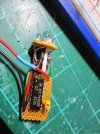Grendels
Active Member
- Joined
- Nov 24, 2009
- Messages
- 9,092
I am pretty sure you had something wrong with that capacitor. I have used that value before without a double blink to it. But if not, then I can see that would be useful!
I still have not had time to get up to my hobby room and check this out. I will try to on Saturday.
I still have not had time to get up to my hobby room and check this out. I will try to on Saturday.



